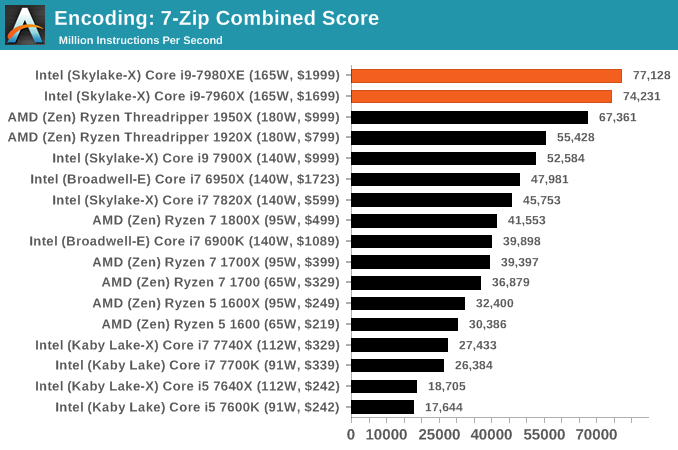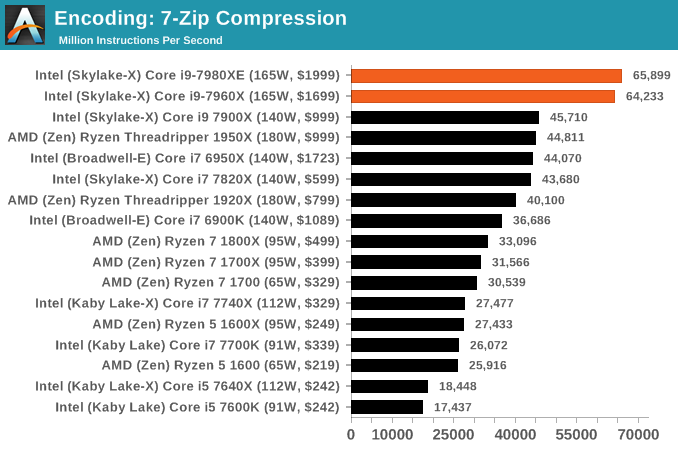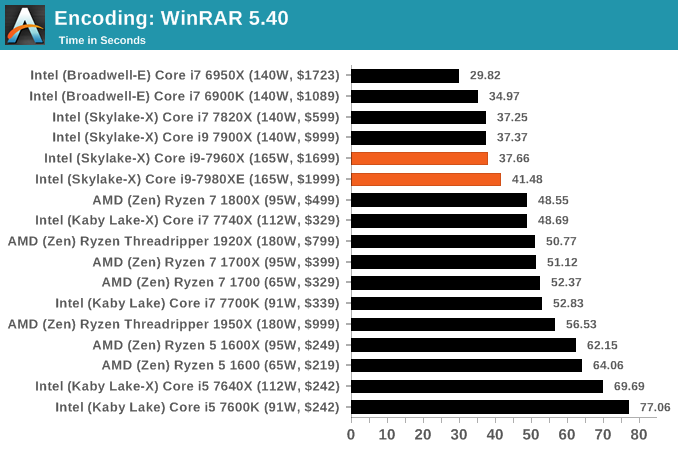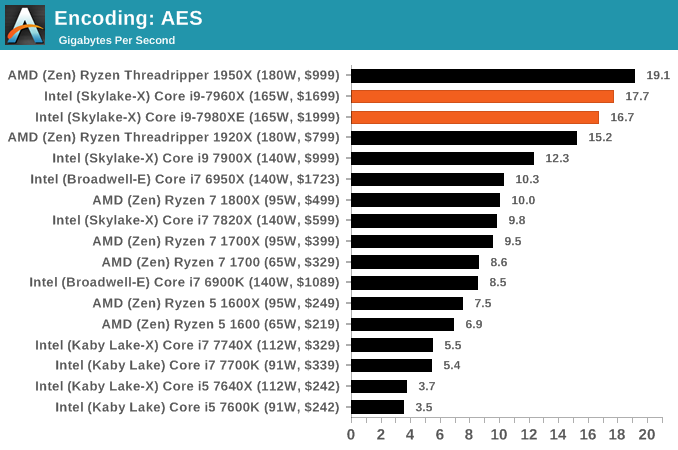The Intel Core i9-7980XE and Core i9-7960X CPU Review Part 1: Workstation
by Ian Cutress on September 25, 2017 3:01 AM ESTBenchmarking Performance: CPU Encoding Tests
One of the interesting elements on modern processors is encoding performance. This includes encryption/decryption, as well as video transcoding from one video format to another. In the encrypt/decrypt scenario, this remains pertinent to on-the-fly encryption of sensitive data - a process by which more modern devices are leaning to for software security. Video transcoding as a tool to adjust the quality, file size and resolution of a video file has boomed in recent years, such as providing the optimum video for devices before consumption, or for game streamers who are wanting to upload the output from their video camera in real-time. As we move into live 3D video, this task will only get more strenuous, and it turns out that the performance of certain algorithms is a function of the input/output of the content.
All of our benchmark results can also be found in our benchmark engine, Bench.
7-Zip 9.2: link
One of the freeware compression tools that offers good scaling performance between processors is 7-Zip. It runs under an open-source licence, is fast, and easy to use tool for power users. We run the benchmark mode via the command line for four loops and take the output score.



WinRAR 5.40: link
For the 2017 test suite, we move to the latest version of WinRAR in our compression test. WinRAR in some quarters is more user friendly that 7-Zip, hence its inclusion. Rather than use a benchmark mode as we did with 7-Zip, here we take a set of files representative of a generic stack (33 video files in 1.37 GB, 2834 smaller website files in 370 folders in 150 MB) of compressible and incompressible formats. The results shown are the time taken to encode the file. Due to DRAM caching, we run the test 10 times and take the average of the last five runs when the benchmark is in a steady state.

AES Encoding
Algorithms using AES coding have spread far and wide as a ubiquitous tool for encryption. Again, this is another CPU limited test, and modern CPUs have special AES pathways to accelerate their performance. We often see scaling in both frequency and cores with this benchmark. We use the latest version of TrueCrypt and run its benchmark mode over 1GB of in-DRAM data. Results shown are the GB/s average of encryption and decryption.

HandBrake v1.0.2 H264 and HEVC: link
As mentioned above, video transcoding (both encode and decode) is a hot topic in performance metrics as more and more content is being created. First consideration is the standard in which the video is encoded, which can be lossless or lossy, trade performance for file-size, trade quality for file-size, or all of the above can increase encoding rates to help accelerate decoding rates. Alongside Google's favorite codec, VP9, there are two others that are taking hold: H264, the older codec, is practically everywhere and is designed to be optimized for 1080p video, and HEVC (or H265) that is aimed to provide the same quality as H264 but at a lower file-size (or better quality for the same size). HEVC is important as 4K is streamed over the air, meaning less bits need to be transferred for the same quality content.
Handbrake is a favored tool for transcoding, and so our test regime takes care of three areas.
Low Quality/Resolution H264: Here we transcode a 640x266 H264 rip of a 2 hour film, and change the encoding from Main profile to High profile, using the very-fast preset.

High Quality/Resolution H264: A similar test, but this time we take a ten-minute double 4K (3840x4320) file running at 60 Hz and transcode from Main to High, using the very-fast preset.

HEVC Test: Using the same video in HQ, we change the resolution and codec of the original video from 4K60 in H264 into 4K60 HEVC.











152 Comments
View All Comments
tamalero - Wednesday, September 27, 2017 - link
Hey guys, question.. Toms and others have mentioned that they HAD to put watercooling to keep this thing stable.Did the same happened to your sample? Wouldnt that increase the "cost of ownership" even more than the intel counterpart?
I mean, the mobo, the ram, the watercooling kit and then the hefty processor?
samer1970 - Wednesday, September 27, 2017 - link
Water cooling is for overclocking only ... you will be okay using 170 watt TDP rated air cooler if you dont oc.0ldman79 - Wednesday, September 27, 2017 - link
I'm going to grab another cup-o-coffee and read it again, but the performance per dollar, AMD costs about half as much as Intel for several comparable models, how does Intel have better performance per dollar on so many of those graphs?Admittedly my kids are driving me nuts and I've been reading this for two days now trying to finish...
silvertooth82 - Thursday, September 28, 2017 - link
if this is all true... let's say thanks to AMD for poking IntelAnnonymousCoward - Friday, September 29, 2017 - link
Very nice review. So compared to a 6700K/7700K, the 18-core beast is marginally slower in single-thread, and only 2-3x faster in multi-thread.I found the time difference when opening the big PDF to be the most interesting chart. 65W Ryzens take a noticable extra second.
Exceeding the published TDP sounds like lawsuit territory.
nufear - Monday, October 2, 2017 - link
Price for Intel Core i9-7980XE and Core i9-7960XMy opinion, I can not justify to spend extra $700~1k on these processors. The performances weren't that significant.
rwnrwnn7 - Wednesday, October 4, 2017 - link
AVX-512 - What software work with him?for what it used today?
rwnrwnn7 - Wednesday, October 4, 2017 - link
AVX-512 - What software work with him?for what it used today?
DoDidDont - Friday, October 27, 2017 - link
Would have been nice to see the Xeon Gold 6154 in the test. 18 cores / 36 threads and apparently an all core turbo of 3.7Ghz, plus the advantage of adding a second one on a dual socket Mobo.Planning a pair of 6154's on either an Asus WS C621E or a Supermicro X11DPG-QT and Quad GPU set up.
My 5 year old dual E5-2687w system scores 2298 in Cinebench R15, which has served me well and paid for itself countless times over, but having dual 6154's will bring a huge smile to the face for V-ray production rendering.
My alternative is to build two systems on the i9-7980XE, one for content creation, single CPU, single GPU, and the other as a GPU workhorse for V-ray RT, and Iray, single CPU, Quad GPU+ to call on when needed.
So the comparison would have been nice for the various tests performed.
sharath.naik - Sunday, December 3, 2017 - link
Isn't there supposed to be part 2!!!